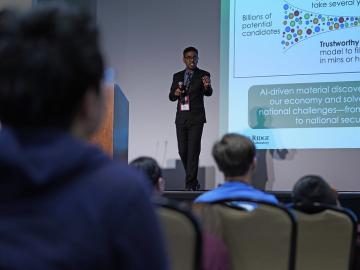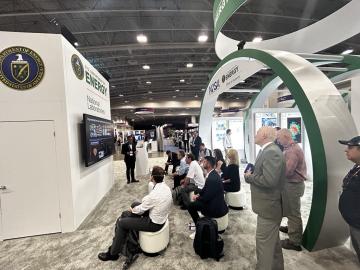
Filter News
Area of Research
- Advanced Manufacturing (1)
- Biology and Environment (20)
- Clean Energy (27)
- Computational Biology (2)
- Computational Engineering (2)
- Computer Science (4)
- Electricity and Smart Grid (1)
- Fusion and Fission (2)
- Fusion Energy (1)
- Isotopes (3)
- Materials (36)
- Materials for Computing (9)
- Mathematics (1)
- National Security (12)
- Neutron Science (13)
- Nuclear Science and Technology (3)
- Quantum information Science (2)
- Supercomputing (52)
News Type
News Topics
- (-) Artificial Intelligence (61)
- (-) Mathematics (9)
- (-) Microelectronics (3)
- (-) Microscopy (31)
- (-) Nanotechnology (28)
- (-) Polymers (17)
- (-) Renewable Energy (1)
- (-) Security (12)
- (-) Space Exploration (22)
- (-) Statistics (2)
- (-) Summit (37)
- 3-D Printing/Advanced Manufacturing (73)
- Advanced Reactors (21)
- Big Data (44)
- Bioenergy (67)
- Biology (78)
- Biomedical (40)
- Biotechnology (15)
- Buildings (39)
- Chemical Sciences (38)
- Clean Water (27)
- Climate Change (74)
- Composites (17)
- Computer Science (127)
- Coronavirus (28)
- Critical Materials (17)
- Cybersecurity (17)
- Decarbonization (55)
- Education (1)
- Emergency (2)
- Energy Storage (61)
- Environment (149)
- Exascale Computing (28)
- Fossil Energy (5)
- Frontier (26)
- Fusion (40)
- Grid (46)
- High-Performance Computing (56)
- Hydropower (11)
- Irradiation (2)
- Isotopes (33)
- ITER (5)
- Machine Learning (33)
- Materials (79)
- Materials Science (81)
- Mercury (10)
- Molten Salt (6)
- National Security (45)
- Net Zero (10)
- Neutron Science (76)
- Nuclear Energy (75)
- Partnerships (20)
- Physics (34)
- Quantum Computing (25)
- Quantum Science (41)
- Simulation (39)
- Software (1)
- Sustainable Energy (92)
- Transformational Challenge Reactor (3)
- Transportation (62)
Media Contacts

At ORNL, a group of scientists used neutron scattering techniques to investigate a relatively new functional material called a Weyl semimetal. These Weyl fermions move very quickly in a material and can carry electrical charge at room temperature. Scientists think that Weyl semimetals, if used in future electronics, could allow electricity to flow more efficiently and enable more energy-efficient computers and other electronic devices.

The world’s fastest supercomputer helped researchers simulate synthesizing a material harder and tougher than a diamond — or any other substance on Earth. The study used Frontier to predict the likeliest strategy to synthesize such a material, thought to exist so far only within the interiors of giant exoplanets, or planets beyond our solar system.

Two ORNL teams recently completed Cohort 18 of Energy I-Corps, an immersive two-month training program where the scientists define their technology’s value propositions, conduct stakeholder discovery interviews and develop viable market pathways.

Researchers at the Department of Energy’s Oak Ridge National Laboratory and partner institutions have launched a project to develop an innovative suite of tools that will employ machine learning algorithms for more effective cybersecurity analysis of the U.S. power grid.

A newly established internship between ORNL and Maryville College is bringing cybersecurity careers to a local liberal arts college. The internship was established by a Maryville College alumni who recently joined ORNL.

Oak Ridge National Laboratory scientists have developed a method leveraging artificial intelligence to accelerate the identification of environmentally friendly solvents for industrial carbon capture, biomass processing, rechargeable batteries and other applications.

Researchers at ORNL and the University of Maine have designed and 3D-printed a single-piece, recyclable natural-material floor panel tested to be strong enough to replace construction materials like steel.

Prasanna Balaprakash, a national leader in artificial intelligence, or AI, spoke to some of the highest achieving students in the country at the National Science Bowl in Washington D.C.

ORNL researchers and communications specialists took part in the inaugural AI Expo for National Competitiveness in Washington D.C, May 7 and 8, to showcase and provide insight into how the lab is leading the way for utilizing the vast possibilities of AI.

Oak Ridge National Laboratory scientists ingeniously created a sustainable, soft material by combining rubber with woody reinforcements and incorporating “smart” linkages between the components that unlock on demand.


